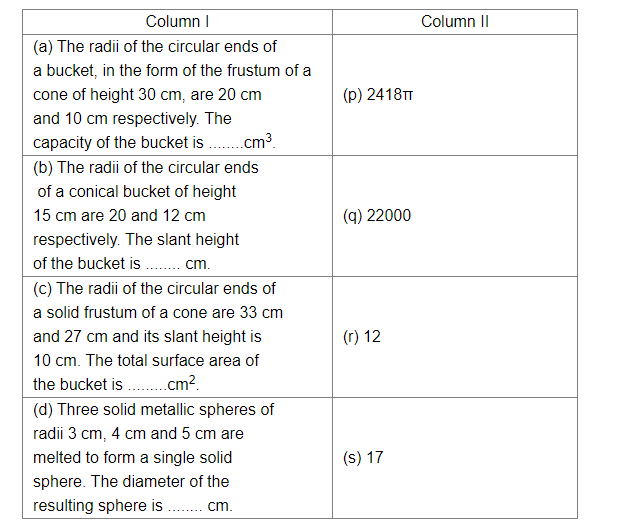Match the following columns:

(a)
Volume of the sphere $=\frac{4}{3} \pi r^{3}$
$=\left(\frac{4}{3} \pi \times(8)^{3}\right) \mathrm{cm}^{3}$
Volume of each cone $=\frac{1}{3} \pi r^{2} h$
$=\frac{1}{3} \pi \times(8)^{2} \times 4 \mathrm{~cm}^{3}$
Number of cones formed $=\frac{\text { Volume of the sphere }}{\text { Volume of each cone }}$
$=\frac{4 \pi \times 8 \times 8 \times 8 \times 3}{3 \times \pi \times 8 \times 8 \times 4}$
$=8$
Hence, $(a) \Rightarrow(q)$
(b)
Volume of the earth dug out $=$ Volume of the cylinder
$=\pi r^{2} h$
$=\frac{22}{7} \times 7 \times 7 \times 20$
Let the height of the platform be $h$.
Then, volume of the platform = volume of the cuboid
$=(44 \times 14 \times h) \mathrm{m}^{3}$
Therefore,
$\frac{22}{7} \times 7 \times 7 \times 20=44 \times 14 \times h$
$\Rightarrow 3080=616 \times h$
$\Rightarrow h=\frac{3080}{616}$
$\Rightarrow h=5 \mathrm{~m}$
Hence, $(b) \Rightarrow(s)$
(c)
Volume of the sphere
$=\frac{4}{3} \pi r^{3}$
$=\frac{4}{3} \pi \times 6 \times 6 \times 6$
Let $\mathrm{h}$ be the height of the cylinder.
Then, volume of the cylinder $=\pi r^{2} h$
$=\pi \times 4 \times 4 \times \mathrm{h}$
Therefore,
$\frac{4}{3} \pi \times 6 \times 6 \times 6=\pi \times 4 \times 4 \times \mathrm{h}$
$\Rightarrow \frac{4}{3} \times 6 \times 6 \times 6=4 \times 4 \times \mathrm{h}$
$\Rightarrow 228=16 \times \mathrm{h}$
$\Rightarrow \mathrm{h}=\frac{228}{16}$
$\Rightarrow \mathrm{h}=18 \mathrm{~cm}$
Hence, $(c) \Rightarrow(p)$
(d)
Let the radii of the spheres be $R$ and $r$ respectively.
Then, ratio of their volumes $=\frac{\frac{4}{3} \pi R^{3}}{\frac{4}{3} \pi r^{3}}$
Therefore,
$\frac{\frac{4}{3} \pi R^{3}}{\frac{4}{3} \pi r^{3}}=\frac{64}{27}$
$\Rightarrow \frac{R^{3}}{r^{3}}=\frac{64}{27}$
$\Rightarrow\left(\frac{R}{r}\right)^{3}=\left(\frac{4}{3}\right)^{3}$
$\Rightarrow \frac{R}{r}=\frac{4}{3}$
Hence, the ratio of their surface areas $=\frac{4 \pi R^{2}}{4 \pi r^{2}}$
$=\frac{R^{2}}{r^{2}}$
$=\left(\frac{R}{r}\right)^{2}$
$=\left(\frac{4}{3}\right)^{2}$
$=\frac{16}{9}$
$=16: 9$
Hence, $(d) \Rightarrow(r)$
Click here to get exam-ready with eSaral
For making your preparation journey smoother of JEE, NEET and Class 8 to 10, grab our app now.
